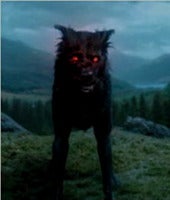Post by Joanna on Jun 30, 2014 3:09:14 GMT -5
Lore and Legend of the Black Dog
Walking along a dark and lonely path one warm night, I saw a flash of lightning up ahead in the distance. It was then that I saw the dog. He was huge, at least as big as a calf. Standing a little to the left of me just off the path he simply stood and stared, big red eyes shone in the flash from another bolt of lightning. Somehow I knew this wasn't anything of this world, but I did not observe any malevolence in the dog’s demeanor. Slowly the apparition faded from sight and was gone. Almost in a trance, I continued on my way.
Although the above story is fiction, there have been hundreds, perhaps even thousands, of stories concerning encounters with strange black dogs dating from Medieval times and even earlier.
So What are Black Dogs? Black dogs have been around for a long time and the term refers to apparitions of creatures that resemble a black dog although not all are black, there have been reports of phantom dogs of grey, white or yellow. Others are headless or two-headed, but the majority manifest as huge black canines, much larger than regular dogs and often described as “calf-size” or the size of a pony. Their coats may be shaggy, curly, glossy, shiny, smooth, soft or bristly, and their eyes are fiery, flaming or glowing, usually red, and very large, often said to be “big as saucers.” According to some reports, the beings are foul-smelling – something on the order of sulphur (brimstone) – an indication they are from the nether regions. Sometimes an observer recalls vaporous breath and a few have seen black dogs that foam or slaver. Those who have seen their teeth claim they are very large and the animal is almost grinning.
Though usually silent, the howls of hellhounds are occasionally heard and people have also detected the “padding” of their feet. Few bark or growl, but there have been reports of the creatures bellowing out a human-like laugh or even talking. At times, the phantom dog can be felt or heard, but not seen.
Black dogs usually fade away, but on occasion sink into the Earth or disappear in a flash or explosion. Some walk on their hind-legs and the specters may increase or decrease in size and shape-shift and pass through solid objects such as walls or fences.
These manifestations have been reported in Ireland, Germany, Poland, Austria, Croatia, Italy, Scandinavia, Canada and the United States. However, the black dog is most widely-reported in Great Britain.
Black dogs are associated with a particular area. They are often encountered near churchyards, water, solitary graves, gateways, hedges, walls, boundaries, trees, gallows, and buried treasure; or on specific roads, footpaths, lanes and bridges. They also seem to have a special affinity for lonely moorland locations. One theory is that they patrol Ley Lines and in Britain, many older churches are built on Ley Lines or where several Ley Lines intersect. In America, most phantom black dogs are associated with graveyards and for this reason, they are usually referred to as “graveyard dogs.”
“Black Shuck” is one of England’s best-known and most-reported black dogs. This creature roams the countryside and coastline of East Anglia, where Sir Arthur Conan Doyle spent time at the Links Hotel just before writing The Hound of the Baskervilles and many believe Black Shuck served as the inspiration for the hell hound that haunted the moors of Devonshire. Black dogs are known by various names in other part of Britain, some of which are Gytrash, Padfoot, the Barghest, Skriker and Gurt Dog.
Stories of Black Dog Sightings. Probably the very first account of a black dog appeared in the Anglo-Saxon Chronicle in 1127. According to the story, after the arrival of Abbot Henry of Portou at the Abbey of Peterborough on Sunday, many men reported seeing and hearing a large number of gigantic, black and hideous huntsmen astride black horses and he-goats. Their hounds were black as pitch with eyes as big as saucers. In the night, the monks could hear the ghostly huntsmen blowing their horns and this continued until Easter.
On the morning of Sunday, August 4, 1577, in Bungay, Suffolk, during a heavy thunderstorm, a huge black dog entered the church and loped up and down the aisles, killing some of those in attendance and badly burning another. Shortly thereafter, the same specter entered the church at Blythburgh eight miles away, killing two and badly burning the hand of a third. To this day, the scratch marks made by the devil dog can be seen on the front door of Blythburgh’s Holy Trinity Church.
These stories are the exception, not the rule. Most sightings occur in rural areas at night and are witnessed by a single individual. At times, the phantom animal will walk beside a person for some distance, then fade away. Although some insist phantom dogs are harbingers of death, it isn’t always clear whether the person seeing the black dog will die, or if seeing the animal foretells the death of a friend or relative of the person who sees it.
Reactions to the Apparitions. As you can see from the foregoing stories, many people have negative reactions to the appearance of the four-legged specters and it is commonly believed these hounds are demonic manifestations or perhaps the devil himself. In some cases, the entities have been described as friendly and people have attempted to pet them only to have their hands pass through the beasts. Those who feel threatened sometimes try to hit or kick the phantoms if they get too close. If you are lucky – or unlucky – enough to encounter an otherworldly black dog, just keep your wits and remain observant.
Sources: Stockton Heath; Harbingers of Doom, and Ghosts of Britain and Ireland.




